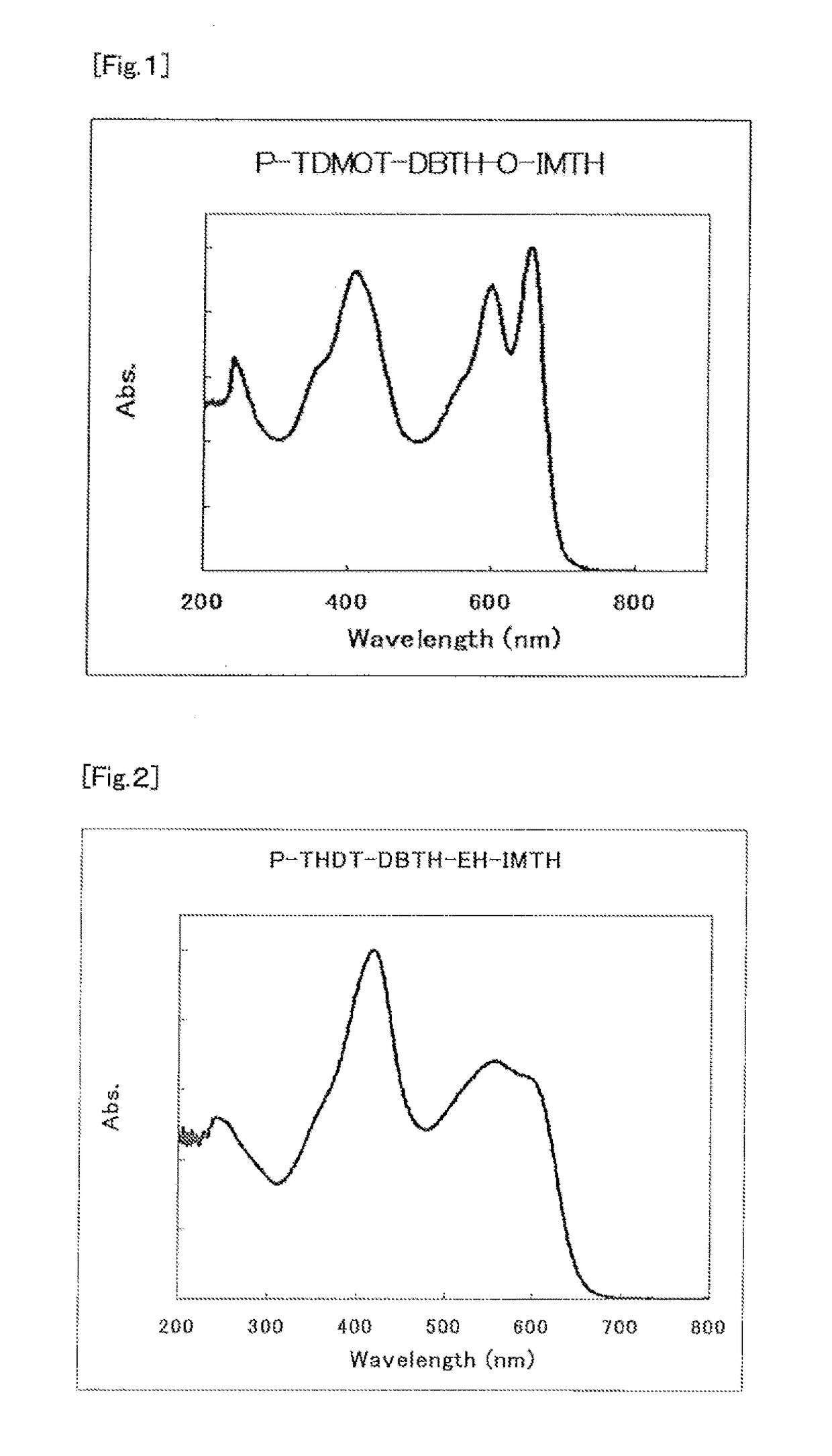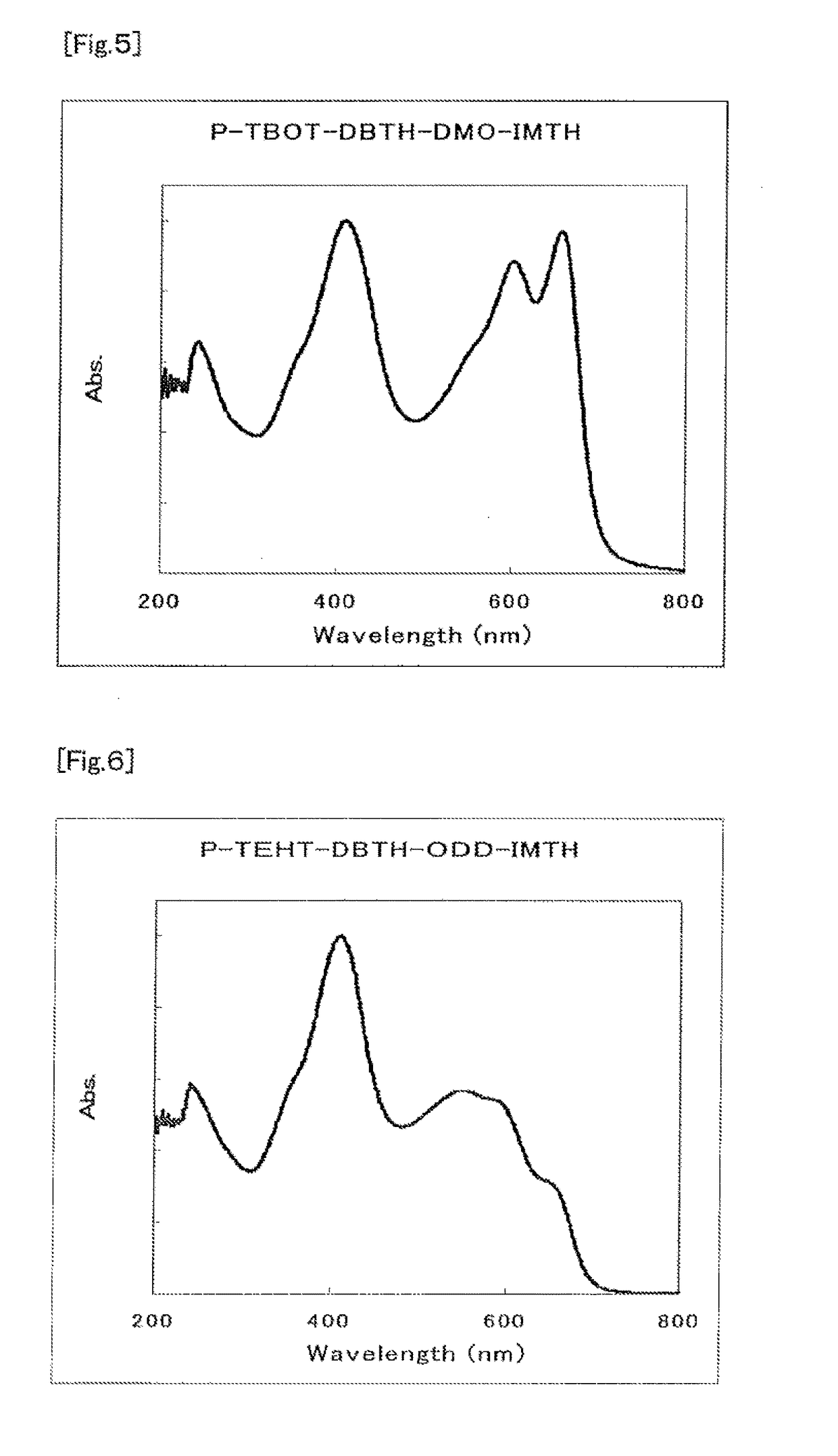Organic semiconductor material
a semiconductor material and organic technology, applied in the field of macromolecular compounds, can solve the problems of insufficient photoelectric conversion efficiency of organic thin-film solar cells, and achieve the effect of high photoelectric conversion efficiency
- Summary
- Abstract
- Description
- Claims
- Application Information
AI Technical Summary
Benefits of technology
Problems solved by technology
Method used
Image
Examples
example 1
Synthesis of 2,6-bis[5-(3,7-dimethyloctyl)thiophene-2-yl]benzo[1,2-d; 4,5-d′]bisthiazole (DBTH-DMOTH)
[0257]
[0258]2,6-diiodobenzo[1,2-d; 4,5-d′]bisthiazole (DBTH-DI, 3 g, 6.76 mmol), tributyl[5-(3,7-dimethyloctyl)thiophene-2-yl]stannane (DMOT-Sn, 12.1 g, 22.6 mmol), tris(2-furyl)phosphine (188 mg, 0.81 mmol), a tris(dibenzylideneacetone)dipalladium (0)-chloroform adduct (420 mg, 0.41 mmol) and N,N-dimethylformamide (60 mL) were added in a 100 mL flask, and reacted at 120° C. for 21 hours. After the reaction was completed, the reaction product was cooled to room temperature, water was then added, the mixture was extracted twice with chloroform, and the organic layer was washed with water, and then dried with anhydrous magnesium sulfate. The organic layer was then filtered and concentrated to obtain a crude product, and the crude product was purified by column chromatography (silica gel, chloroform / hexane=1 / 1) to prepare 2.0 g of 2,6-bis[5-(3,7-dimethyloctyl)thiophene-2-yl]benzo[1,2-d;...
example 2
Synthesis of 2,6-bis[5-(2-ethylhexyl)thiophene-2-yl]benzo[1,2-d; 4,5-d′]bisthiazole (DBTH-EHTH)
[0260]
[0261]2,6-diiodobenzo[1,2-d; 4,5-d′]bisthiazole (DBTH-DI, 2.7 g, 6.03 mmol), tributyl[5-(2-ethylhexyl)thiophene-2-yl]stannane (EHT-Sn, 10.2 g, 22.11 mmol), tris(2-furyl)phosphine (140 mg, 0.60 mmol), a tris(dibenzylideneacetone)dipalladium (0)-chloroform adduct (156 mg, 0.15 mmol) and N,N-dimethylformamide (55 mL) were added in a 100 mL flask, and reacted at 120° C. for 22 hours. After the reaction was completed, the reaction product was cooled to room temperature, water was then added, the mixture was extracted twice with chloroform, and the organic layer was washed with water, and then dried with anhydrous magnesium sulfate. The organic layer was then filtered and concentrated to obtain a crude product, and the crude product was purified by column chromatography (silica gel, chloroform / hexane=1 / 1) to prepare 1.38 g of 2,6-bis[5-(2-ethylhexyl)thiophene-2-yl]benzo[1,2-d; 4,5-d′]bisth...
example 3
Synthesis of 2,6-bis[5-(2-butyloctyl)thiophene-2-yl]benzo[1,2-d; 4,5-d′]bisthiazole (DBTH-BOTH)
[0264]
[0265]2,6-diiodobenzo[1,2-d; 4,5-d′]bisthiazole (DBTH-DI, 0.86 g, 1.93 mmol), tributyl[5-(2-butyloctyl)thiophene-2-yl]stannane (BOT-Sn, 3.4 g, 6.37 mmol), tris(2-furyl)phosphine (72 mg, 0.31 mmol), a tris(dibenzylideneacetone)dipalladium (0)-chloroform adduct (8 mg, 0.08 mol) and N,N-dimethylformamide (20 mL) were added in a 50 mL flask, and reacted at 120° C. for 24 hours. After the reaction was completed, the reaction product was cooled to room temperature, water was then added, the mixture was extracted twice with chloroform, and the organic layer was washed with water, and then dried with anhydrous magnesium sulfate. The organic layer was then filtered and concentrated to obtain a crude product, and the crude product was purified by column chromatography (silica gel, chloroform / hexane=1 / 1) to prepare 0.68 g of 2,6-bis[5-(2-butyloctyl)thiophene-2-yl]benzo[1,2-d; 4,5-d′]bisthiazole...
PUM
| Property | Measurement | Unit |
|---|---|---|
| donor-acceptor-type semiconductor | aaaaa | aaaaa |
| organic semiconductor | aaaaa | aaaaa |
| photoelectric conversion efficiency | aaaaa | aaaaa |
Abstract
Description
Claims
Application Information
 Login to View More
Login to View More - R&D
- Intellectual Property
- Life Sciences
- Materials
- Tech Scout
- Unparalleled Data Quality
- Higher Quality Content
- 60% Fewer Hallucinations
Browse by: Latest US Patents, China's latest patents, Technical Efficacy Thesaurus, Application Domain, Technology Topic, Popular Technical Reports.
© 2025 PatSnap. All rights reserved.Legal|Privacy policy|Modern Slavery Act Transparency Statement|Sitemap|About US| Contact US: help@patsnap.com



